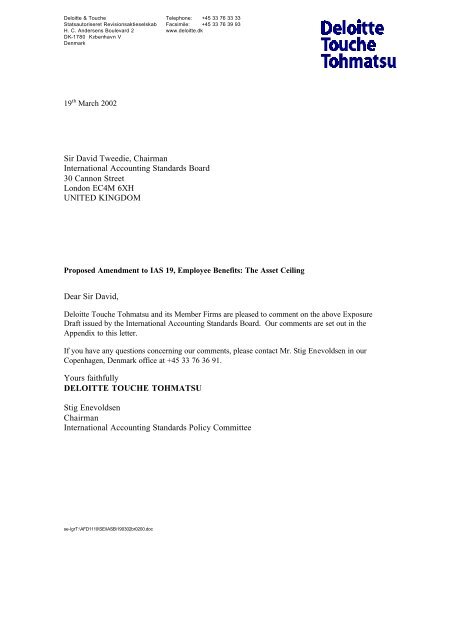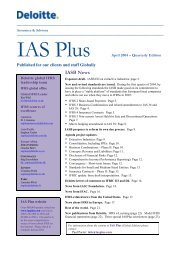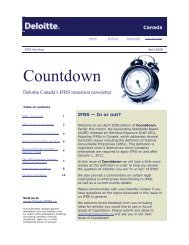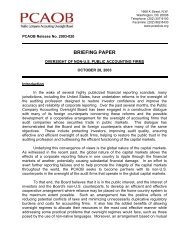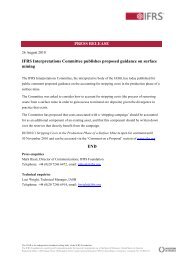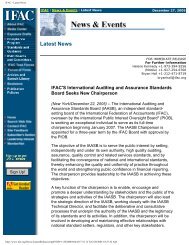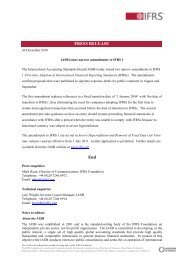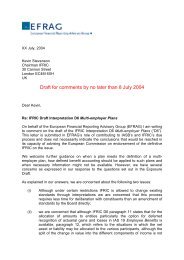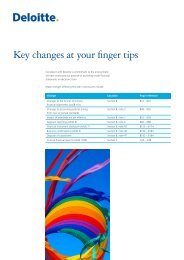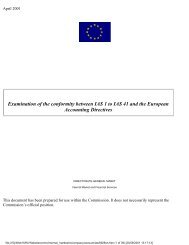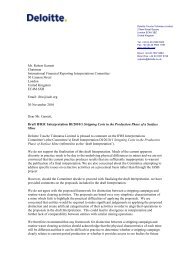Sir David Tweedie, Chairman International Accounting ... - IAS Plus
Sir David Tweedie, Chairman International Accounting ... - IAS Plus
Sir David Tweedie, Chairman International Accounting ... - IAS Plus
Create successful ePaper yourself
Turn your PDF publications into a flip-book with our unique Google optimized e-Paper software.
Deloitte & Touche Telephone: +45 33 76 33 33<br />
Statsautoriseret Revisionsaktieselskab Facsimile: +45 33 76 39 93<br />
H. C. Andersens Boulevard 2 www.deloitte.dk<br />
DK-1780 København V<br />
Denmark<br />
19 th March 2002<br />
<strong>Sir</strong> <strong>David</strong> <strong>Tweedie</strong>, <strong>Chairman</strong><br />
<strong>International</strong> <strong>Accounting</strong> Standards Board<br />
30 Cannon Street<br />
London EC4M 6XH<br />
UNITED KINGDOM<br />
Proposed Amendment to <strong>IAS</strong> 19, Employee Benefits: The Asset Ceiling<br />
Dear <strong>Sir</strong> <strong>David</strong>,<br />
Deloitte Touche Tohmatsu and its Member Firms are pleased to comment on the above Exposure<br />
Draft issued by the <strong>International</strong> <strong>Accounting</strong> Standards Board. Our comments are set out in the<br />
Appendix to this letter.<br />
If you have any questions concerning our comments, please contact Mr. Stig Enevoldsen in our<br />
Copenhagen, Denmark office at +45 33 76 36 91.<br />
Yours faithfully<br />
DELOITTE TOUCHE TOHMATSU<br />
Stig Enevoldsen<br />
<strong>Chairman</strong><br />
<strong>International</strong> <strong>Accounting</strong> Standards Policy Committee<br />
se-lgrT:\AFD1110\SE\<strong>IAS</strong>B\190302br0200.doc
Page 2<br />
DELOITTE TOUCHE TOHMATSU<br />
PROPOSED AMENDMENT TO<br />
<strong>IAS</strong> 19, EMPLOYEE BENEFITS: THE ASSET CEILING<br />
Question 1: Is the issue identified of sufficient importance to warrant a limited<br />
amendment to <strong>IAS</strong> 19?<br />
We acknowledge that the current requirements in <strong>IAS</strong> 19.58 may result in the recognition of a gain or<br />
loss in the income statement that is the result of deferring the recognition of an actuarial gain or loss<br />
under <strong>IAS</strong> 19.92. We believe, however, the larger issue is the need for an asset ceiling and,<br />
ultimately, the acceptability of a “corridor” approach in accounting for actuarial gains and losses.<br />
Therefore, instead of addressing this selected issue related to a specific anomaly, we believe it would<br />
be preferable for the <strong>IAS</strong>B to address this, and other issues with the application of <strong>IAS</strong> 19, as part of a<br />
larger project on employee benefits.<br />
In addition, we understand that the <strong>International</strong> Financial Reporting Interpretation Committee<br />
recently added to its agenda a project on how to determine the present value of economic benefits<br />
available in the form of refunds or reduction in future contributions to the plan under <strong>IAS</strong> 19.58(b)(ii).<br />
This suggests that there are additional issues associated with the asset ceiling. We support this<br />
initiative and the need to develop further guidance on how to determine this amount. Assuming the<br />
<strong>IAS</strong>B decides to move forward with amending <strong>IAS</strong> 19, we suggest that any amendment also address<br />
how the amount in <strong>IAS</strong> 19.58(b)(ii) is determined.<br />
Question 2: Does the proposed amendment to <strong>IAS</strong> 19 (paragraph 58A) appropriately<br />
address the issue? Does it create any anomalies? If the proposed amendment is<br />
inappropriate, can you suggest an alternative?<br />
The proposed amendment represents a modification to the general “corridor” approach, as it requires<br />
partial recognition in the income statement of actuarial gains and losses that would otherwise have<br />
been unrecognized. As noted in <strong>IAS</strong> 19.95, the “corridor” approach is based on the notion that over<br />
time actuarial gains and losses would offset one another. The proposed amendment to recognize<br />
certain actuarial gains and losses in the current period is inconsistent with this notion and would<br />
preclude the natural “offsetting” of unrecognized gains and losses in which the “corridor” approach is<br />
based.<br />
Although the proposed amendment may address the identified anomaly, we believe it results in<br />
additional detailed rules that add increased complexity to an already complex standard. Assuming the<br />
<strong>IAS</strong>B decides to move forward with amending <strong>IAS</strong> 19, we encourage the <strong>IAS</strong>B to consider a less<br />
complex approach that is focused on concepts rather than rules.<br />
As a result, we suggest that any amendment to address the anomaly identified focus on the<br />
relationship between the defined benefit plan surplus and the present value of the economic benefits<br />
available to the employer (i.e., the concept of recoverability). The concept of recoverability is<br />
inherent in other Standards such as <strong>IAS</strong> 2, <strong>IAS</strong> 12, <strong>IAS</strong> 36, and <strong>IAS</strong> 39. Therefore, we believe that a<br />
less complex and equally effective solution to the anomaly identified would be to simply eliminate
Page 3<br />
<strong>IAS</strong> 19.58(b)(i). Consequently, any surplus would be written down to the amount of economic<br />
benefits available in the form of refunds from the plan or reductions in future contributions to the<br />
plan. We note that this generally would be consistent with the approach taken in U.K. Financial<br />
Reporting Standard No. 17.<br />
The Exposure Draft notes that the present value of the economic benefits available cannot exceed the<br />
surplus in an employee benefit plan. We agree with this statement and note the example illustrating<br />
<strong>IAS</strong> 19.60 assumes the present value of available future refunds and reductions in future contributions<br />
exceeds the plan surplus. Therefore, we suggest that <strong>IAS</strong> 19 be amended to correct this illustration.<br />
Question 3: Should the limited changes become effective for accounting periods ending<br />
on or after 31 March 2002, with earlier application encouraged (paragraph 159A)?<br />
We note that the Exposure Draft indicated that the <strong>IAS</strong>B intends to vote on this amendment at its<br />
April 2002 meeting. Assuming the <strong>IAS</strong>B decides to move forward with amending <strong>IAS</strong> 19, we<br />
suggest that the effective date of any amendments not predate the final approval by the <strong>IAS</strong>B.<br />
Therefore, we suggest an effective date for annual financial statements covering periods ending on or<br />
after 30 June 2002, with earlier application encouraged.<br />
Question 4: Do you agree that there should be no specific transitional provisions for the<br />
limited changes proposed in this exposure draft? Consequently, <strong>IAS</strong> 8 “Net Profit or<br />
Loss for the Period, Fundamental Errors and Changes in <strong>Accounting</strong> Policies” will<br />
apply to any changes in accounting policies that are made to comply with <strong>IAS</strong> 19 if<br />
amended as proposed (paragraph 160).<br />
Assuming the <strong>IAS</strong>B decides to move forward with amending <strong>IAS</strong> 19, we agree that no<br />
specific transitional provisions are necessary and that any amendments would be applied<br />
pursuant to <strong>IAS</strong> 8.<br />
se-lgrT:\AFD1110\SE\<strong>IAS</strong>B\190302bi0200.doc
Page 4


